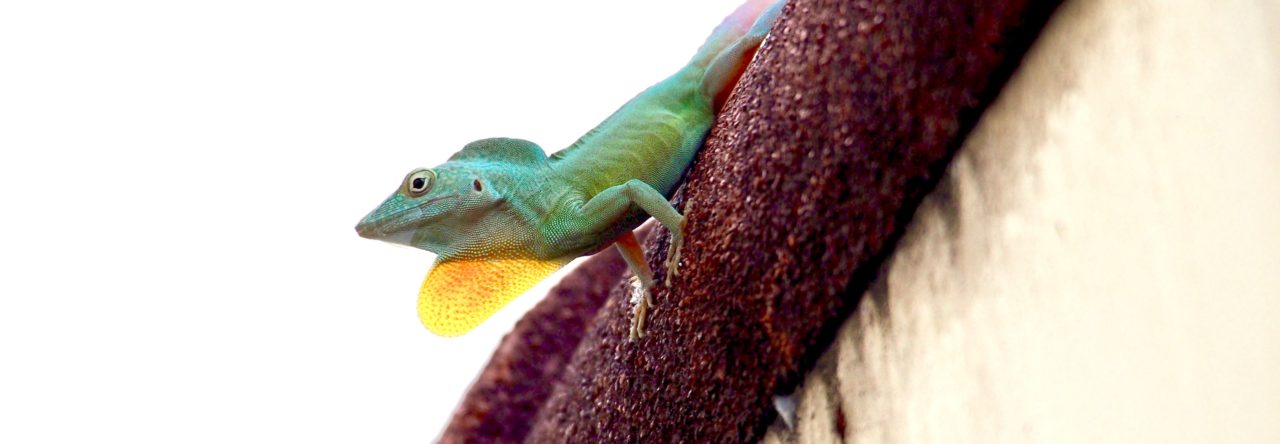Dominica Geographic filed this report on Claire Dufour’s research on Anolis oculatus, which we have reported on previously.
Is the Zandoli Getting Stronger?
July 25, 2019 / No Comments

Dr. Claire Dufour is an ecologist and evolutionary biologist; a postdoctoral fellow of Harvard University, and currently a postdoctoral fellow and teacher at the University of Montpellier, in France. Claire is interested in the dynamic interactions between sister species and their environment. Her focus is on environmental pressures – such as competing or invasive species – on the evolution of ecological, morphological, and behavioural traits of animals such as insects, mammals and reptiles. This work has led her to take a scientific interest in the two competing species of anole (tree lizards) here in Dominica; one of which is the endemic zandoli (Anolis oculatus), the other, the invasive Puerto Rican anole (Anolis cristatellus).

For a number of years, Claire has been studying the co-existence of these two species in Dominica, how they react and behave towards each other, and how co-existing and dealing with extreme weather events such as hurricane Maria have affected behaviour and physical morphology. Her research has suggested a number of interesting outcomes that will require further study.
When the invasive species of anole arrived in the port area around Woodbridge Bay several years ago, its spread around the island was rapid, but it followed a pattern; namely the coastal road system. Claire and other scientists, such as Jacqui Eales who first recorded and studied the invasive species (see Dominica Traveller, second edition), speculate that this movement was probably caused by transportation in vehicles. The invasive anole hitched rides and occupied predominantly a coastal territory (and still does), whereas the endemic zandoli was also present in the interior where it had developed and spread over many, many years. At first, the relationship was feared to be antagonistic in nature, with the native zandoli coming under threat. Claire believes this has now changed and that the two species have settled into a form of coexistence. Moreover, she believes that the native zandoli is now doing better and is, in fact, probably the dominant species.

In order to study anoles, many environmental and morphological attributes are noted and recorded, most of which are too detailed and complex to get into here, but examples include: the location of the tree (or other structure) that the anole is inhabiting; where specifically on the tree the anole likes to hang out (trunk, branches, higher canopy, etc.); any behavioural characteristics (for example towards other anoles); and the physical attributes of the anole itself (size, weight, colour, etc.). A further experiment has been carried out to record behavioural characteristics that involves the innovative use of mimetic robots that are designed to represent both anole species. Claire presents the robots to the lizards and records their behaviour towards specific actions and signals that she is able to control remotely and unobtrusively.
Claire’s research has resulted in many interesting findings, one of which recently made headlines in the scientific community. Claire discovered that, with regard to the anoles she measured and recorded after hurricane Maria, their ability to grip with their toepads had increased by a factor of ten compared to her pre-hurricane tests. In concluding her work this year, Claire says that this attribute appears to have not only continued but has actually increased.
The likely, though unproven, explanation is that the anoles that survived the hurricane by clinging onto trees perhaps already had a strong grip compared to those that perished, and that they may have passed on this genetic trait as part of their morphological evolution. Further studies are needed and Dominica Geographic will follow Claire’s work.
Dominica is a draw for scientific researchers such as Claire because of its relatively unspoilt natural environment, its isolation as an island (it could be viewed as a very large laboratory), and its regionally and locally endemic species. One of the first things that Claire does when she comes here for her field work is engage with local people to get their views of what they have noticed about the two species of anole. Anecdotal evidence provided by local people is often an important foundation for further field research.

If you are interested in recording anoles or any other aspect of natural science in Dominica, here is one fun way to get started. Download the iNaturalist app to your smartphone and start photographing and recording the plants, flowers, birds and other critters you see when you are out walking (yes, you have to get out and explore !). Think about becoming a Dominica ‘citizen scientist’ and helping to record information about the island’s natural environment, and sharing your findings with the world.
Dominica ought to be producing more of its own scientists; encouraging, educating, and financially supporting young people with the interest and the potential. Many visiting researchers are very open to engaging and sharing their work with local people but often find it difficult to do so. More could be done to provide them with the facilities they need (classroom, lab, accommodation and so on); facilities that could also be used by a home-grown scientific community.
- Evolution in Real Time on Lizard Island - March 23, 2025
- Spider Snags Adult Anolis osa - March 22, 2025
- An Homage to the Green Anoles of New Orleans - March 21, 2025


Rick Wallach
It’s nice to read about another anole besides sagrei invading somewhere or other, isn’t it?
Bob G Cannon II
Great article and research. I would like to know more about Dr. Claire Dufour and her work. Anole robots… amazing.